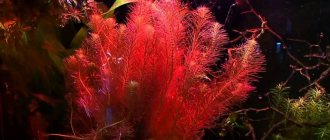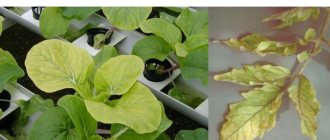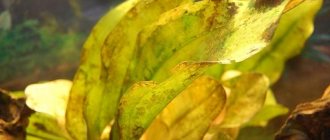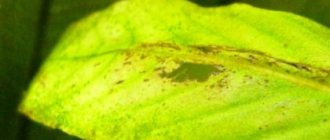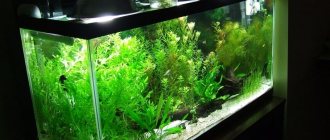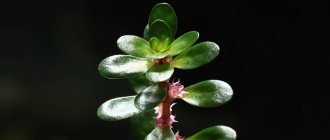Rotala macrandra from the loosestrife family is one of the most beautiful long-stemmed aquarium plants. Several hybrids are united under this name, the most popular among which are rotala makrandra, rotala macrandra angustifolia, rotala macrandra green, rotala green makrandra angustifolia.
The most impressive and spectacular of them is the rotala makrandra. Thanks to the rich red color of its unusually thin oval leaves, rotala will decorate any aquarium with its presence. However, please note that while being one of the most beautiful, this plant is also one of the most whimsical. Therefore, before you decide to use rotala to decorate your aquarium, think about whether you are ready for this important step.
General characteristics of rotala macrandra
Rotala macrandra is native to India, although today you can find it in most warm water bodies.
The plant grows up to 25-55 cm in length. Oval-shaped leaves with wavy edges are tightly attached to the long, weakly branched stems. Their sizes reach 4 cm in width and 5 cm in length. The leaves are located in pairs on both sides of the stem, symmetrically in relation to one another. The color of the leaf above and below differs: the lower part is characterized by a purple tint, the color of the upper part can vary from pale pink to bright red, depending on the lighting.
Description
Rotala macrandra is an aquarium plant native to India. In its homeland, it can be found growing along the coast in silty soils. A long-stemmed plant, it grows straight up under water, turning bright red. Above the water it spreads along the surface and turns green. The plant reaches a height of 20-30 cm and is often used in nano aquariums as a background plant.
Despite the fact that rotala makrandra is a rather difficult plant to maintain, it is quite easy to purchase and the price is quite low.
In addition to the traditional standard sample of rotal macrandra, other varieties of this plant are also known:
- Rotala macrandra “green”;
- Rotala macrandra “narrow leaf”;
- Rotala macrandra “variegated”;
- Rotala macrandra “green narrow leaf”;
- Rotala macrandra sp mini
Plant conditions
It is necessary to create all the conditions for Rotala macrostamena to feel comfortable in an artificial reservoir. The water temperature should not be lower than 27 °C, but should not exceed 30 °C. If it drops to 26 °C and below, the rotala will stop growing, its young leaves will begin to shrink, and the old ones will fall off.
It is also necessary to constantly monitor water hardness. It is optimal if its indicator is within 2-4°. In such water with a slightly acidic or neutral reaction, rotala will grow and develop well. In addition, you need to ensure good water circulation in the aquarium.
The purity of the water should be kept under control. It needs to be replaced regularly, plus peat extract must be added. The presence of certain chemicals, such as sodium ions, can negatively affect the condition of the plant. Therefore, you should not add baking soda and table salt to the aquarium.
Indica Rotala - jackpot for the aquarium
Indica is valued not only for its exotic hydrophyte, but also for its ability to maintain the biological balance of the biosystem environment. In the Rotala aquarium, Indian serves as a kind of filter, participating in metabolic processes:
- absorbs carbon dioxide;
- produces oxygen;
- neutralizes excess nitrates and phosphates.
The grass is considered a “litmus test”, reacting with the color of its leaves to any changes in water balance.
05:34
Pros and Cons of Long Stem Plants in the Aquarium. Features of keeping Long stems
02:21:06
Aquarium plants will tell you what they need. Unscientific stream.
01:03:49
Lecture by Dmitry Parshin - About algae and more. Part 2
Lighting for rotala is like oxygen for humans
To ensure that the leaves always have a beautiful red tint, you need to install fairly bright lighting. In this case, it is desirable that the light source with a predominant red-orange range be located directly above the rotala. There should be at least 12 hours of daylight, but make sure that algae does not begin to appear in the aquarium, which is dangerous for the heat-loving plant. This is especially true for blue-green algae.
The main problem in creating suitable conditions for algae is the difficulty of establishing optimal lighting, in which the lower leaves would be as beautiful as the upper ones. Observe the size of the rotala leaves: if they are less than 2 cm in length, look for your mistakes, since the environment is clearly not meeting the needs of the plant.
Growing and care
The red-leaved rotala will decorate almost any tropical aquarium due to its spectacular appearance. However, only experienced aquarists can afford this plant. Rotala macrandra is very demanding when it comes to living conditions.
At the slightest deviation from the norm, it loses its attractiveness or dies. It is considered the most difficult to breed compared to other variations.
Large-stamen rotala is most demanding on the state of the water if it is in a floating state and not fixed in the ground. The floating form of the plant grows more slowly compared to the ground form and is generally small in size.
- It is best to use rotala macrandra to decorate a Dutch aquarium. Less commonly, it is used when creating a composition using the concept of “Nature Aquarium” by Takashi Amano. This is partly due to the complexity of the idea of recreating a piece of nature in artificial conditions, since it requires a deep understanding of the principles of biological balance.
- You can grow red-leaved rotala both in an aquarium and in a wet greenhouse. It is suitable for foreground decoration. Although it is often placed on the sides of the aquarium. The aesthetic value is determined not only by the purple color of the leaves, but also by their smooth top layer, reminiscent of a varnish coating.
Water parameters for ideal maintenance
Rotala macrandra is very picky about water, especially about its temperature. It should be maintained between 26 and 30 degrees Celsius. In colder conditions, rotala slows down growth until it stops, after which it begins to degrade and die.
The following recommended values must be maintained in water:
- total hardness dH— 2-7º;
- carbonate hardness KH - 1-10º;
- acid-base balance - 5-7.
If the water hardness exceeds 12º, the large-stamen rotala dies, and the alkaline environment is uncomfortable for it.
Another important condition is the purity of the water in the aquarium. Be sure to change 1/3 of its total volume every two weeks.
If the liquid is cloudy, Rotala macrandra grows more slowly and takes on an unattractive appearance. At the same time, strong water flow is also not welcome.
For example, with a flow created by the operation of a powerful filter, weak roots suffer and leaves fall off.
Lighting requirements
A large amount of light is the most important condition for good growth of Rotala macrostamena. There should be enough luminous flux for each sheet. Otherwise, the plant will begin to stretch and wither, which is why it is highly advisable to systematically thin out the foliage if the bush grows, so that the leaves do not block each other.
Under the right conditions, young foliage has a red-pink color, which can serve as a guide for the aquarist.
When planting rotala in an aquarium, it is recommended to place the sprouts directly under light sources.
The optimal lighting intensity is 80-100 Lm/l. It is advisable to choose lighting devices capable of generating light rays predominantly in the red spectrum. It is useful to use incandescent light bulbs and combine them with fluorescent lamps or natural light.
The latter should be limited to 2 hours a day. The optimal length of daylight is approximately 14 hours.
As the owners of the rotala note, despite the high lighting requirements, it can exist in slight shading if necessary. It should be borne in mind that excess light can lead to the growth of algae, which worsens the condition of the ecosystem in the aquarium.
Requirements for soil, nutrient substrate
The root system of red-leaved rotala is very weak and belongs to the creeping type. Leaf buds are usually present on the rhizome. Sometimes new roots appear on the stems of the bush, which begin to spread along the surface of the soil.
Despite the fact that under natural conditions Rotala macrandra grows mainly in silty soil, a large amount of silt in an aquarium will have a negative effect. The recommended substrate thickness is 3 cm. The structure of the soil should be similar to coarse sand. It is desirable that it be sufficiently nutritious.
Among the professional substrates for keeping rotala, ADA Aqua Soil Africana is suitable. This soil has an average nutritional level compared to the more fertile Amazonia and the poorer Malaya. However, unlike the Amazon, it has less effect on the hardness and acidity of water, without causing jumps in indicators.
Another advantage of its use when growing rotala makrandra is the presence of a large amount of iron, which is necessary to maintain the bright color of the plant’s leaves.
For good growth of Rotala macrandra, it would be a good idea to purchase an additional nutritious substrate containing clay and peat.
Requirement for fertilizers
It is useful to use mineral fertilizers as top dressing.
The only limitation is that, compared to other plants, red-leaved rotale requires half as many macro- and microelements.
It is best to divide the recommended amount of fertilizer into several parts and apply gradually.
Depending on the amount of nitrates, rotala can change color. In particular, with an increased amount of nitrates, the color changes to orange.
Phosphates, on the contrary, help maintain bright red shades.
Because of this, the dosage of fertilizers with macroelements should be treated with special attention.
Large-stamen rotala categorically does not tolerate sodium ions that enter the water when baking soda or table salt is added.
Carbon dioxide must be added to the water at a concentration of 15-20 mg/l. It allows you to maintain a beautiful decorative appearance of the plant. Another essential element is iron. It can be obtained in sufficient quantities from special liquid fertilizers, such as:
- Tetra Plant Florapride Red. This fertilizer was developed for plants with a lot of red pigment. In addition to iron, it is rich in manganese and potassium. Helps the plant develop faster, while preventing the growth of algae that is undesirable for any tropical aquarium.
- Aquarium Leaf Zone. In this fertilizer, the main emphasis is placed on chelated iron and potassium-containing compounds, which are much better absorbed by plants.
- Florastim Fe. This chelated micronutrient supplement contains ferrous iron, which many experienced aquarists prefer to use instead of ferric iron. It is believed that the latter is highly oxidized and less easily absorbed.
Soil for plants with a delicate root system
The rhizome of Rotala krupnotychkovy is creeping and has many leaf buds. Due to the underdeveloped root system, you can observe how additional roots appear on the stems, which spread along the water surface.
However, in any case, rotala must be planted in soil that is sufficiently nutritious and not too silty. When planting a plant, add a few lumps of peat and clay under its roots.
Since the root system is very delicate, it is best to use not too fine river sand as a substrate. The soil layer should not exceed 3 cm.
Mineral feeding
Keep in mind that in addition to lighting, the color of rotala leaves is also affected by the presence of iron, which the plant obtains from water. If you want rotala to delight you with a rich red color, take care of mineral feeding. But do not forget that you should feed rotala with extreme caution because of its poor reaction to the slightest excess of salts in the water.
Apply the fertilizer in parts so that you have several applications throughout the week. Remember that the concentration of mineral fertilizers should be 2-3 times less than the recommended rate for other plants.
Lifehacks and tips for aquarists
- Tip #1. In some cases, after cuttings are planted in an aquarium, they produce new shoots that initially float freely in the water. If there are no obvious signs of deterioration in the condition of such floating sprouts, experienced aquarists recommend waiting for the roots to appear. After this, the plant should be fixed in the ground.
- Tip #2. You cannot plant rotala macandra in an aquarium with herbivorous fish and crustaceans that are prone to digging. Some owners of this capricious plant prefer to use them exclusively in Dutch aquariums due to increased sensitivity. Rotala can also be “bruised” by overly active predatory fish.
- Tip #3. When decorating an aquarium, it is better not to plant too many sprouts of Rotala macrostamena. Its bright red color can steal all the attention. In a small-volume vessel, experts recommend limiting yourself to 1-2 stems. Several stems located on cascading “paths” against the backdrop of green plants look advantageous. In general, Rotala macrandra is used to create accents in the overall composition.
- Tip #4. Red-leaved rotala actively branches, especially when approaching a light source. Many plant owners prefer to trim it from the top. At the same time, experts recommend completely uprooting the plant, then cutting off and replanting the upper part of the stem.
Reproduction rotala
Rotala, like all long-stemmed plants, is characterized by propagation by stem cuttings. The length of the cuttings should be at least 7-10 cm, otherwise they will grow extremely slowly. If you take a cutting from the middle part of the stem for propagation, make sure that it has formed a side shoot.
When performing any manipulations with the rotala, do it very carefully. Its delicate leaves react poorly even to a light touch of fingers. Therefore, when replanting, try to minimize the time the plant spends in the air.
If you are growing rotala in a container with a low water level, make sure that its top is not above the surface.
Ground shoots, once exposed to air, will quickly lose their decorative properties. Also, once out of the water, the plant may bloom, which will also not have the best effect on its appearance. Creation date: 11/24/2015
Appearance
Mudskippers are more amphibian in appearance than fish. Their elongated body can reach sizes from 5 to 25 cm. The head is disproportionately larger than the body; at the very top of its head there is a pair of eyes without eyelids.
Mudskipper. Appearance
The tail is short but muscular, it allows the fish to move by jumping. The pectoral fins are modified into organs resembling the legs of amphibians and are used for movement on land. The anal fin has turned into a ventral “sucker”. The dorsal fin is rectangular, long, divided into two parts and shimmers in different colors: blue, black, yellow, reddish.
Mudskippers are capable of high jumps using their tails
The gill slit is small and can close tightly to retain moisture.
The main body color is gray-brown with a large number of spots and silvery sparkles. There are many tubercles on the skin in which gas exchange occurs during skin respiration.
Sexual dimorphism is not expressed.
Let's take a closer look at each feature of the mudskipper.
Unusual eyes.
The organs of vision are located on the top of the fish’s head and, like a periscope, allow you to examine the surface of the reservoir from under the water. They do not have eyelids, so to wet the eyes, the mudskipper has to repress them together or alternately, covering them with a special fold of skin.
Mudskipper Eyes
Features of breathing.
If you look closely at the mudskipper, you will find a massive upper lip and voluminous gill covers. These organs allow the fish to stay out of water for a long time. Before reaching land, the jumper takes water into its mouth and presses the gill slits tightly to retain a small amount of moisture. It is this moisture that wets the gills and prevents them from drying out. The only thing that is required is regular replenishment of water “reserves”. Unfortunately, this structural feature does not allow the fish to fully breathe oxygen dissolved in water, so jumpers have adapted to use atmospheric air, periodically swallowing it. Fish are also able to breathe through their skin due to the presence of special mucus, and amphibians breathe similarly.
Mudskippers live in bodies of water with low oxygen levels
Unusual movements.
The tail stalk of mudskippers is a real “spring”. It is capable of bending under the body and, if necessary, straightening sharply, pushing the fish upward to a height of up to 30 cm. This helps them run away from natural enemies, jump onto mangrove branches so as not to be blown away into the sea, and is used in mating games. The fins of jumpers are also of an unusual shape. The pectoral fins are modified, their base resembles a paw, and the end resembles a flipper. This double structure allows the limbs to be used both for swimming and for land-based “walking” (the fish alternately rests on one or the other fin). The pelvic fins are fused and act as suction cups to hold the fish on vertical surfaces. This is necessary so that the jumpers are not carried out to sea during low tide.
With the help of modified pectoral fins, mudskippers are able to crawl on land
The whole life of fish is closely connected with the ebb and flow of the tides. During high tide they burrow into the mud or swim near the bottom, and during low tide they crawl through the mud. Mudskippers feed on other predatory fish, herons and water snakes.
